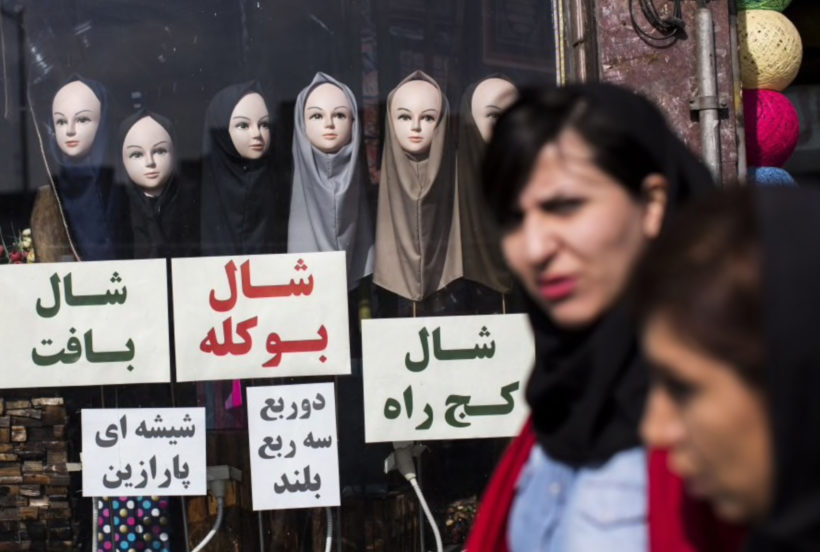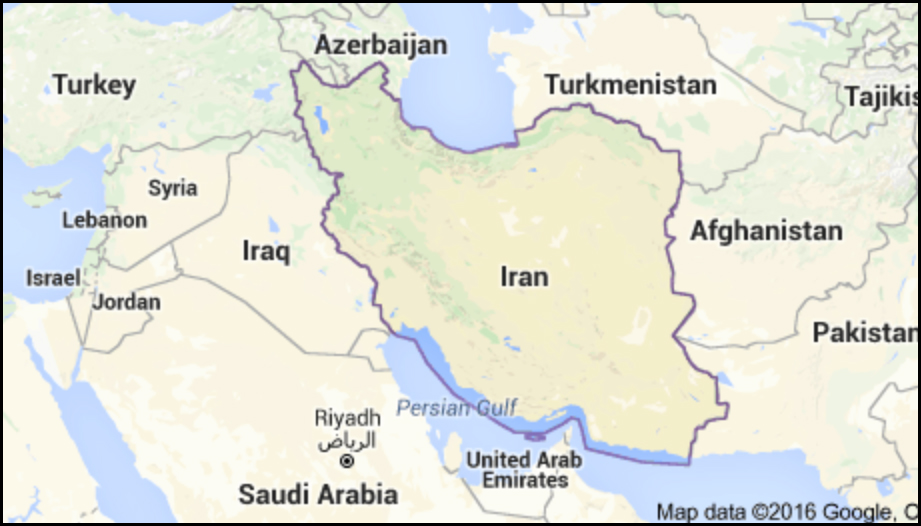
In this file photo taken on Feb 24, 2016 Iranian women walk past a shop displaying hijabs (headscarves) on mannequins in the downtown district of the capital Tehran. Tehran police have arrested 29 women for appearing in public without a headscarf as protests against the dress code in force since the Islamic revolution of 1979 intensify, Iranian media reported on Feb 2. (AFP / Behrouz Mehri)
redo Jump to...
print Print...
(from Germany’s Deutsche Welle news, Feb. 2) – Police in Iran have arrested 29 women who were waving their headscarves to protest the Islamic government’s law which forces women to wear them at all times in public. The protest has gained steam online as demonstrations continue in Iran.
Iranian police said on Thursday that 29 women had been arrested for protesting the country’s compulsory hijab rules, the private Tasnim news agency reported. Tasnim has strong links to the Iranian Revolutionary Guards and aims to defend “the Islamic Republic against negative media propaganda.”
Iran’s Islamic law, imposed after the 1979 Islamic revolution, requires women to cover their hair and wear long, loose-fitting clothes in public. Six other women were also reportedly taken into custody this week.
A growing number of women in Iran have been removing their hijabs and waving them on a stick to protest the Iranian law.
Several images and videos of the demonstrations have gone viral on social media. The protests have coincided with huge demonstrations against economic conditions in eastern Iran. Some have called for the country’s supreme leader, Ayatollah Ali Khamenei, to step down. …
The hijab-waving demonstration is part of a campaign started by exiled Iranian journalist Misah Alinejad, who one year ago encouraged women to post images and videos of themselves on social media with the hashtag #whitewednesdays.
The trend picked up momentum after videos in images were posted online in late December of a woman who was arrested for waving her hijab on a street corner in Tehran.
“We are fighting against the most visible symbol of oppression,” said Alinejad, who also hosts the website My Stealthy Freedom. “These women are saying ‘It is enough — it is the 21st century and we want to be our true selves.'”
Police in Iran seemed to take an indirect shot at Alinejad’s campaign on Thursday, saying the 29 arrested women were “tricked” into removing their hijabs by a propaganda campaign spread by Iranians living abroad, the news agency Tasnim [aligned with the Iranian Revolutionary Guard] reported.
This article originally appeared on DW .com. Its content was created separately to USA TODAY.
(Read more in a commentary about the courageous women of Iran)
Questions
1. For IRAN, give the following information:
- capital
- location/the countries that share its borders
- the religious breakdown of the population
- the type of government
- the chief of state (and head of government if different) If monarch or dictator, since what date has he/she ruled? – include name of heir apparent for monarch
- the population
Find the answers at the CIA World FactBook website. For each country, answers can be found under the “Geography” “People” and “Government” headings.
NOTE: Before answering the questions below, read the info under “Background” and watch the videos under “Resources.”
2. For IRAN:
a) list the who, what, where and when of the news item
b) How does the Islamic Republic’s law require women to dress?
c) Read the “Background” and watch the videos below. What 2 or 3 adjectives would you use to describe the women in Iran who are risking fines and prison to stand up for their right to choose? Explain your answer.
Background
Women in Iran:
Under the Pahlavi Dynasty: The Pahlavi Shahs were the rulers of Iran between 1925 and 1979 and they introduced many reforms concerning women’s rights.
- An example of an early reform introduced by Reza Shah was the ‘forced unveiling of women by a special decree on January 8, 1936’
- Under Reza Shah, women’s involvement in society in general increased. Iranian women increasingly participated in the economy, the educations sector and in the workforce. Levels of literacy were also improved.
- Examples of women’s involvement: women acquired high official positions, such as ministers, artists, judges, scientists, athletes, etc.
- Under Reza Shah’s successor, his son Mohammad Reza Shah, many more significant reforms were introduced. For example, in 1963, the Shah granted female suffrage and soon after women were elected to the Majlis (the parliament) and the upper house, and appointed as judges and ministers in the cabinet.’.
- In 1967 Iranian family law was also reformed which improved the position of women in Iranian society. It was included in the civil code and was designed to protect wives, children and female divorcees. The general thrust of the reforms were to promote equality between men and women in society.
- The Family Protection Laws of 1967 and 1973 required a husband to go to court to divorce rather than simply proclaim the triple talaq of “I divorce thee” three times, as stipulated by traditional sharia law. It allowed a wife to initiate divorce and required the first wife’s permission for a husband to take a second wife.
- Child custody was left to new family protection courts rather than automatically granted to the father.
- The minimum age at which a female could marry was raised from 13 to 15 in 1967 and to 18 in 1975.
Following the 1979 Iranian Revolution in which the Shah was overthrown, Iran became an Islamic Republic. An Islamic republic is the name given to several states that are officially ruled by Islamic laws (Sharia Law), including the Islamic Republics of Afghanistan, Iran, Pakistan, and Mauritania. (from wikipedia)
The following is from an Oct. 2016 article by Dr. Majid Rafizadeh, an Iranian-American political scientist published at Front Page Mag: The following are some of the rules for women which are derived from Iran’s Islamic constitution and moral police codes:
- Women are prohibited from showing strands of their hair on any side. Article 683 states: “Those women that appear in the streets and public places without the Islamic hijab, shall be sentenced from ten days to two months’ imprisonment or fined from fifty thousand to five hundred thousand Rials.”
- Women are not allowed to wear hats instead of veils to cover their hair.
- Iranian women are prohibited from riding bicycles. Iran’s Supreme Leader, Ayatollah Ali Khamenei, recently issued an Islamic fatwa regarding officially banning women from riding bicycles. He argued that “riding bicycles often attracts the attention of men and exposes the society to corruption, and thus contravenes women’s chastity, and it must be abandoned,” according to Iran’s state-run media.
- Women are not allowed to initiate divorce. Men have the right to do so.
- Iranian Muslim women cannot marry non-Muslim men. But Iranian Muslim men can marry non-Muslim women.
- According to Iran’s family code, women cannot travel abroad except with the permission of their custodian or natural guardian (husband, father, etc.). They also cannot obtain a passport without the consent of their husbands.
- Women are banned from receiving the same amount of inheritance as their male relatives. Even if a husband dies, the wife will receive only one-eighth of the inheritance if she has a child.
- Women are forbidden from having any physical contact with men, including shaking hands.
- Women are not allowed to have any kind of alcoholic drinks.
- Women are not allowed to dance.
- In many of Iran’s provinces, women are banned from performing music on stage.
- Women are prohibited from entering sport stadiums and watching men’s sports.
- In Iran, buses and subways are divided in two sections. The larger front section is for men, the smaller back section is for women. Women are prohibited from entering the men’s section even if there are no seats left in the back and there are plenty of empty seats in front of the bus.
Resources
Visit the My Stealthy Freedom facebook page and twitter page.
Watch three news reports:
A Feb. 1 CBC News report with exiled Iranian journalist Misah Alinejad Feb. 1, 2018—
Iranian women protest mandatory headscarves
From United News International – Feb. 2, 2018
Women protest hijab laws in Iran – from The National January 30, 2018
Daily “Answers” emails are provided for Daily News Articles, Tuesday’s World Events and Friday’s News Quiz.




